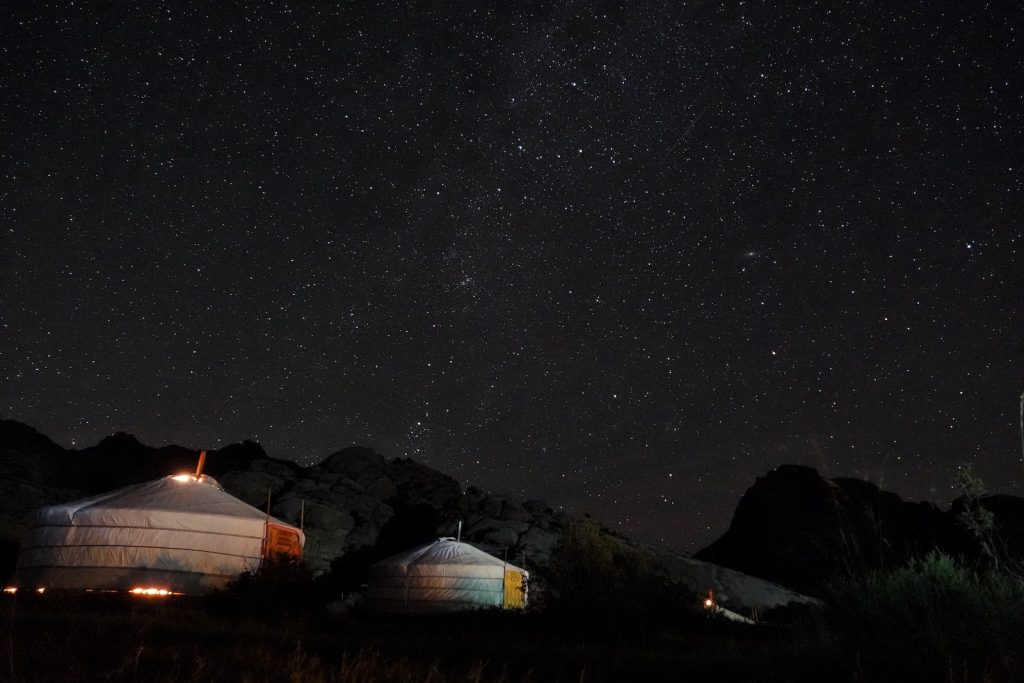My first morning in the Land of the Eternal Blue Sky was cloudy and gray. After packing into a small bus at our hotel in Ulaanbaatar and driving an hour west, our group watched a tsam, or masked dance ritual performance, as part of Danshig Naadam, a major Buddhist festival in Mongolia.
Monks wearing large, expressive papier-mâché masks of Tibetan Buddhist deities danced in the center of a big circle to an absorbing blend of sound—long horns, short horns, drums, and bells. They wore heavily adorned costumes in bright colors—blue, white, red, green, and yellow. A giant thangka painting of Vajrapani—a wrathful protector bodhisattva surrounded by flames—served as the ritual backdrop. Skulls filled the scene: monks in skull masks, masks with skull crowns, and a go-kart filled with skulls of different sizes.
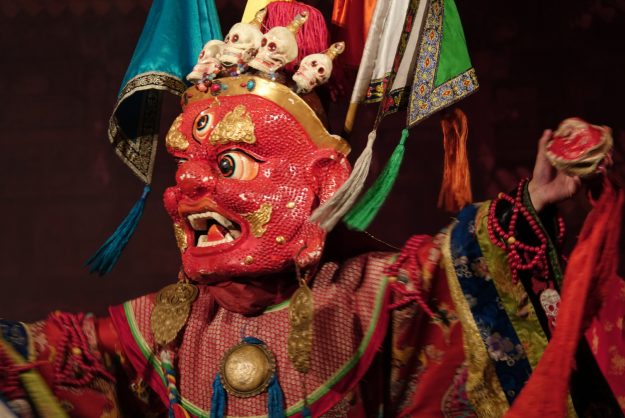
Seeing this, I thought to myself: What am I doing here? I could answer this question in a practical sense: I was on a Tricycle-sponsored pilgrimage to sacred Buddhist sites with sixteen other travelers. At heart, each of us was seeking some personally meaningful combination of Buddhist practice, beauty, adventure, connection, culture, and the unknown.
The unknown? Check. While I couldn’t completely follow the narrative unfolding through the tsam, a monk explained that it signified the triumph of protector deities over demons who have threatened to destroy Buddhism. Although versions of this ritual have been performed at Danshig Naadam for hundreds of years, this sequence of events evokes Mongolia’s more recent Buddhist history.
Held annually since 1639, Danshig Naadam stopped in 1921, when Mongolian revolutionaries and Soviets ushered in the Communist era, purging the country of all religious practice. Even though Communist rule in Mongolia ended in 1990, the festival wasn’t revived until 2015.
The tsam is part of a multiday, family-friendly cultural festival featuring sports competitions in archery, horse racing, wrestling, and sheep-ankle shooting. Carnival games, bounce houses, camel rides, and eagle handling are also part of the festivities. Most significantly, however, Danshig Naadam celebrates the enthronement of Zanabazar—a crucial figure in Mongolian Buddhist history—as the country’s first Bogd Jebtsundamba Khutuktu, or supreme Buddhist leader.
***
Zanabazar appeared in many forms during our two-week pilgrimage in central Mongolia, as statues, paintings, and in stories. In addition to his status as the first supreme spiritual leader of the country, he is also highly regarded as a sculptor, painter, architect, fashion designer, and linguist. To help translate Tibetan Buddhist texts, he created the Soyombo script, the source for the famous Soyombo symbol now featured on the Mongolian flag. He is credited with leading a 17th-century Buddhist revival in Mongolia, adapting Tibetan Buddhism to Mongolian sensibilities, and founding monasteries and temples nationwide. More than once, Zanabazar was described to me as the “Leonardo da Vinci of Mongolia.”
This same Renaissance spirit was embodied in our pilgrimage caravan’s host, the well-connected and charismatic Gursed Tserenpil. Shortly after he picked me up from the airport, I learned that he managed Buddha Production, a company that broadcasts all of Mongolia’s major Buddhist events. Later, I discovered that he also owns Buddha World Travel. This company specializes in taking Mongolians on the Buddhist pilgrimage circuit in India and Nepal; the employees wear shirts with the slogan “Explore in The Peace of Emptiness.” During Danshig Naadam, I learned that Gursed had written a song that was playing over the loudspeaker. “Just the words,” he shrugged. The song was about the 9th incarnation of Zanabazar, Khalkha Jetsun Dampa, who died in 2012. Gursed was his student.
Before departing Ulaanbaatar, we visited Gandan Monastery, the heart of Mongolian Buddhism. At the center of the monastery complex is an 87-foot-tall bronze statue of Avalokiteshvara, the bodhisattva of compassion. After the original statue was destroyed and reportedly melted down for bullets in 1937 by the Communists, it was rebuilt in 1996. “This statue is the symbol of the restoration of Buddhism in Mongolia,” said Miga, a monk from another monastery in Ulaanbaatar who traveled with our group for a few days.
Outside of the temple with the rebuilt statue, a wooden post from the original temple had been reclaimed by Mongolians as a “wishing tree.” I watched the faithful line up to circumambulate the tree three times and whisper their wishes. Someone told me the original abbot’s spirit was still in the wishing tree, explaining that its never having been destroyed was proof that it retained its magic power.
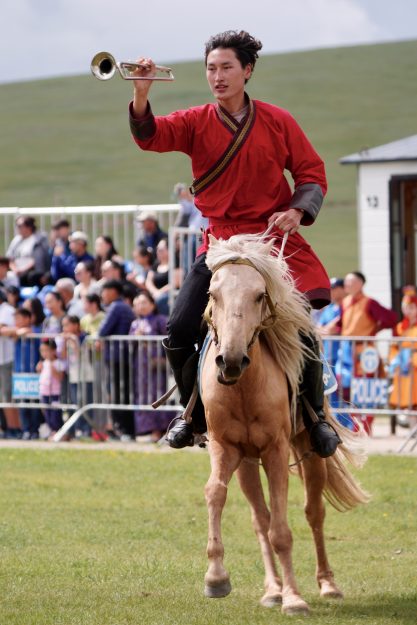
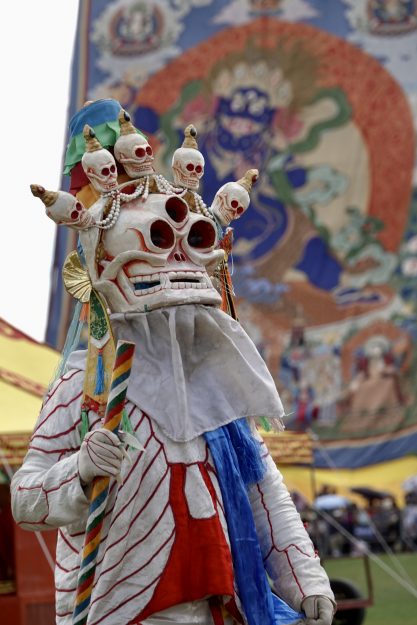
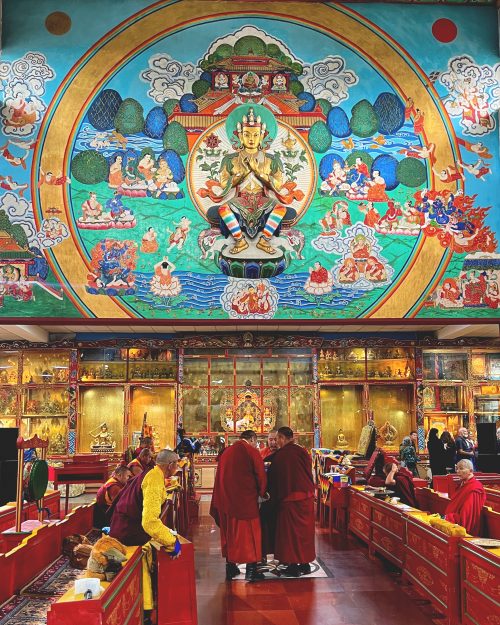
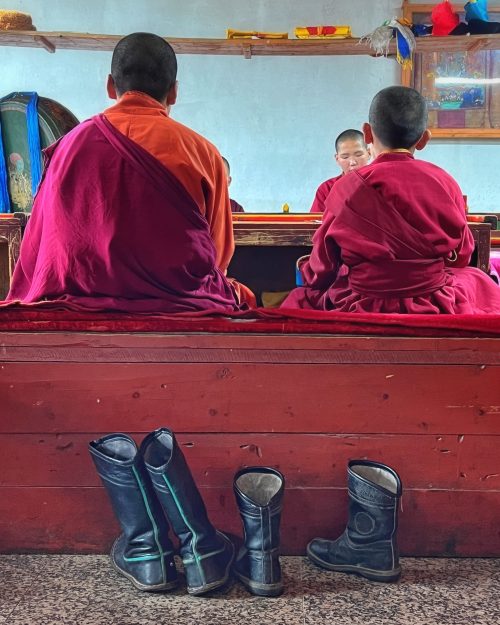
Gandan’s grounds seemed to be a powerful place to go with wishes. Inside the main temple was an area where you could request special mantras for whatever ailed you. People would take a number, fill out a form, wait their turn, and pay the monks to recite mantras on their behalf the following morning.
Despite this modern, bureaucratic approach to ending suffering, it was at Gandan that I first began to appreciate the long history of Buddhism in Mongolia on its own terms and not simply as an extension of Tibetan Buddhism. In addition to the more immediately observable differences—like the blue khatas (traditional ceremonial scarves) representing the Eternal Blue Sky—Gandan is where I learned that Tibetan Buddhism wouldn’t be the Tibetan Buddhism we know today without Mongolia’s influence.
After a couple of nights in the gers, or traditional Mongolian yurts, at Khogno Khan Uul Nature Camp—where we also visited the ruins of the 17th-century Ovgon Monastery built by Zanabazar—we participated in a mandala ritual with a group of monks at Erdene Zuu Monastery in Kharkhorum, the ancient capital of the Mongol Empire. Gursed had arranged this for us, naturally.
I was holding a small replica of a temple—containing a Buddha, a sutra, and a stupa—in the front of a line where our group was standing in two rows side by side, a multicolored rope draped over our left shoulders. In front of us, four monks made a 3D mandala by dumping barley into concentric rings building upward. We were creating a link between the pure world and our world. The temple, which I understood to represent our world, was growing heavy in my hands. The monks’ chanting was getting louder. I was sweating. “Are you OK?” a fellow pilgrim whispered. When we finally handed the temple back to the monks, I was relieved to learn that our world had been turned into a pure world.
Afterward, Megan Mook, the American Buddhist teacher who accompanied our group, interpreted the ritual for me. She said our world can be the pure world, and your teacher can be the Buddha. The Buddha’s mind, which is your enlightened mind, is everywhere. “These rocks,” she said, gesturing to the path beneath our feet, “are shining like gemstones.”
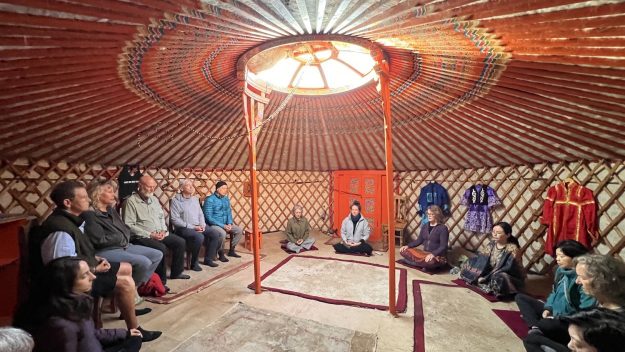
Like many contemporary Buddhist teachers, Mook often used the sky as a metaphor for the enlightened mind. “What you think, feel, and say, and what others think, feel, and say about you,” she said, are “like clouds in the sky.”
At this point in the pilgrimage, I started to notice some clouds hanging around inwardly. I missed my family, my routines, even my work. As it had so often in my life, travel began by sparking the question “What am I doing here?” but at some point morphed into, “What am I doing there?” Back home, raising a young family with my wife, I had settled into my responsibilities. But I hadn’t become complacent, right?
“There’s a little sky inside you, and there is a big sky outside of you,” Mook said, “and they’re the same sky.” Her words echoed themes throughout the dharma discussions she led. At the end of meditation practices, we often dedicated the merit we generated to ourselves and others. Mook would add, “with the recognition that self and others are not as separate as they seem.” To underscore this, we would say, “May I be kind to myself, may I be kind to others,” and when saying “myself,” we would think of others, and when saying “others,” we would think of ourselves.
“There’s a little sky inside you, and there is a big sky outside of you,” Mook said, “and they’re the same sky.”
That night, we were introduced to various Mongolian games played with the ankle bones of sheep. Our Mongolian guide and translator, Agiimaa Batmunkh—taking time off from her lawyer job in parliament to travel with us—taught us which animals were represented by the four sides of the ankle bone: goat, sheep, camel, and horse. We could roll four ankles and match our animals to a fortune-telling card. Roughly 90 percent of the fortunes were terrible. Mine read: “fortunate on other’s side.” Luckily, I had just learned to say “others” and think of myself.
***
It was sunny when we started our hike to Tövkhön Monastery, southwest of the ancient capital. Zanabazar founded this monastery when he was 13 years old, and it was his summer temple for thirty-five years. It is where he created most of his art, including the Soyombo script. BJ Graf, cofounder of Tricycle’s pilgrimage partner RetreaTours, described it as the most important pilgrimage site for Mongolian Buddhists. There were a couple dozen horses and a few motorcycles at the mountain’s base, but I was surprised there weren’t more pilgrims.
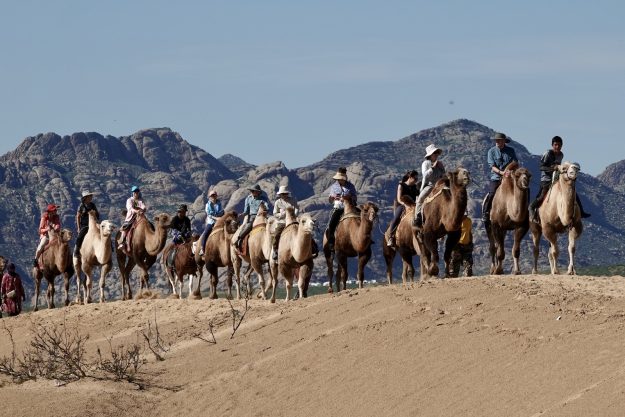
We walked slowly through a forest of larch trees and purple fireweed wildflowers. When we arrived, a monk in the main temple told us that the monastery had been destroyed twice, once in the 17th century by a competing Mongolian leader and then again in the 1930s by the Soviets. There has now been daily religious activity since 1997.
Sitting in the temple, Mook gave a dharma talk on devotion. It works, she said, because it helps you empty yourself. After the teaching ended, the clouds emptied themselves. “We just generated potential,” Mook commented as it started to rain. “The way to capitalize on that potential is to give it away.” Mook said that rain could be an either auspicious or inauspicious sign.
***
There aren’t many paved roads in Mongolia. Mostly, we were off-road, weaving between herds of livestock on braided dirt roads. The bumpy travel stood in contrast to the smooth steppes outside the window, which RetreaTours cofounder Lauren Rathvon described as looking like the original Microsoft screensaver. We traveled like this by van to various places en route to our final ger camp.
While we bounced around in the back, a fellow pilgrim and our van DJ blasted “traditional” pilgrimage songs like Bon Jovi’s “Livin’ on a Prayer,” Guns N’ Roses’ “Patience,” and AC/DC’s “Highway to Hell.”
The bluest sky I ever saw in Mongolia was while visiting the massive stainless steel statue of Chinggis Khaan riding a horse. Seeing nothing but blue in all directions, I understood why Chinggis worshipped the sky. “Do you think this is life-size?” a fellow pilgrim joked. “It would explain how he was able to conquer so much of the world.”
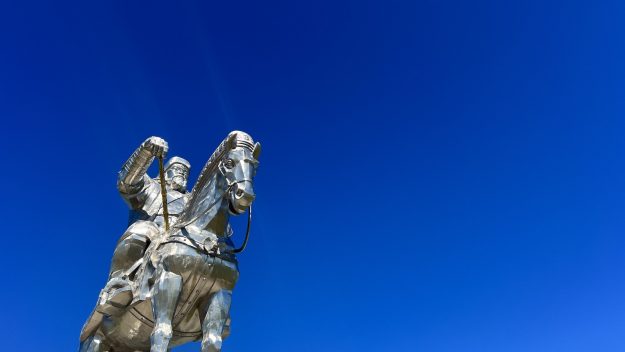
Our last stop before returning to Ulaanbaatar was at the eco-friendly luxury gers of Jalman Meadows inside the Khan Khentii Strictly Protected Area. Different shades of purple and white wildflowers dotted the rolling green hills and valleys around us. One of our afternoon meditation sessions was interrupted by the sudden appearance of a big and bright rainbow, reminding us of the pure world.
The next day, during the unfamiliar but enjoyable experience of galloping on horseback across the open steppe, more questions arose: Who am I? And then, briefly, after almost losing my balance: What happens after we die?
During a meteor shower that night, I left my ger to take in the stars. Looking up, I imagined myself looking down at the remote spot where I was on the planet. How could anybody ever know what they are doing here? Not having an answer didn’t feel like confusion. My little sky was clear.
***
On the last day of our pilgrimage, Gursed arranged meetings with two Mongolian Buddhist national treasures: the religious leader Khamba Lama Natsagdorj, nicknamed the “Medicine Buddha” for his efforts to heal through traditional Mongolian medicine and Western medicine, and the celebrated Chöd, or tantric practitioner, Kunze Chimed.
“History is very unusual,” Khamba Lama Natsagdorj said after reflecting on the multiple waves of Buddhist revival in Mongolia. He wore a bright yellow robe with light blue sleeves. He had a knack for understated but powerful summations of complex topics. On comparing Western and traditional Mongolian medicine: “One disadvantage to Western medicine is that it doesn’t account for the mind and heart, which are connected to the body.”
Later that afternoon, my mind, heart, and body were transported by a Chöd ritual by Kunze Chimed. Her soft and urgent voice accompanied a small two-sided drum, bell, and thigh-bone flute. She also used a vajra, or small ritual object common to tantric practice. Chimed explained the ritual as a practice of giving yourself to the things that scare you most, which is why it’s often practiced on charnel grounds. It’s a strategy for helping you cut through your ego. I remembered the skulls everywhere at Danshig Naadam.
There was a depth to Kunze Chimed’s eyes, which gave the impression that she had become intimate with what scared her most. She received transmission to practice and perform two traditions of Chöd, including one by the 9th incarnation of Zanabazar, the same person Gursed wrote a song about. In Mongolia, all braided dirt roads lead to Zanabazar. And Gursed.
When we left the performance, it started to rain. Auspicious or inauspicious? I had doubts when, as we drove to dinner, the Ulaanbaatar traffic crawled at the pace of a mandala ritual. We were far from the freedom of galloping on horses across the open steppes. The rain fell cool, in small scattered drops. There wasn’t any blue in the sky, but I knew it was there and that it would come back, even if I couldn’t see it.
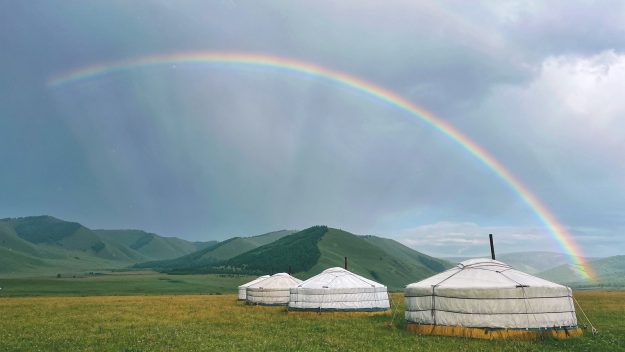
Thank you for subscribing to Tricycle! As a nonprofit, we depend on readers like you to keep Buddhist teachings and practices widely available.
